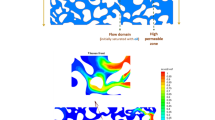Abstract
Accurate knowledge of the multicomponent phase behavior of carbon dioxide (\(\hbox {CO}_2\)) with hydrocarbon fluids is needed in the design, operation and development of carbon dioxide-based enhanced oil recovery (EOR) techniques, in particular, understanding the phase behavior of \(\hbox {CO}_2\) and hydrocarbon fluids system. In recent years, the possibility of sequestering \(\hbox {CO}_2\) (a greenhouse gas) in underground (oil) reservoirs has been proposed. The feasibility will also be affected by the phase behavior of \(\hbox {CO}_2\) in the presence of chemical species present in the reservoirs (Al-Marri in PVT, phase behavior and viscosity measurements and modeling of the ternary and binary systems of carbon dioxide \(+\) heavy hydrocarbon (n-eicosane) \(+\) light gas (ethane or propane), Ph.D. Thesis, University of Southern California, 2006). PVT viscosity and vapor–liquid equilibria are important in EOR process, reservoir simulations and process design. Phase behavior consists of two parts, in the first part the recombination process takes place by inserting the data of surface fluids into the PVT simulation to determine various fluid properties and especially the bubble point at reservoir temperature. In the second part, the swelling test is introduced by inserting the data of carbon dioxide (99.6% purity) as injection fluid into the recombined fluid to investigate the swelling factors. The modified Peng–Robinson equation of state was used for predicting saturation pressure. For fluid mixtures, the Van Der Waals mixing rules are commonly used. Results of the simulation were compared with the experimental data showing that the saturation pressure of the recombined fluid/\(\hbox {CO}_2\) system was strongly affected by the concentration of carbon dioxide. Thus, this enhanced the oil recovery from heavy oil reservoirs.
Similar content being viewed by others
References
Al-Marri, S.S.: PVT, phase behavior and viscosity measurements and modeling of the ternary and binary systems of carbon dioxide \(+\) heavy hydrocarbon (\(n\)-eicosane) \(+\) light gas (ethane or propane). Ph.D. Thesis, University of Southern California (2006)
Mohammad, R.S.: PVT study of selected UAE reservoir fluids. M.Sc. Thesis, UAE University, Al Ain, UAE (2012)
Danesh, A.: PVT and Phase Behaviour of Petroleum Reservoir Fluids. Developments in Petroleum Science, vol. 47. Elsevier Science. ISBN:0-44482196-1 (1998). https://www.elsevier.com/books/pvt-and-phase-behaviour-of-petroleum-reservoir-fluids/danesh/978-0-444-82196-6
Schlumberger: DBR oilphase PVT simulation tutorial. http://www.slb.com/~/media/Files/core_pvt_lab/product_sheets/fluid_lab_software_pvt_pro_ps.pdf
Bon, J.: Laboratory and modelling studies on the effects of injection gas composition on \(\text{CO}_{2}\)-rich flooding in Cooper basin. Ph.D. Thesis, The University of Adelaide, Australia (2009)
Yuan, S.; Ye, J.; Sun, Z.: Theory and Practice in Gas-Condensate Reservoir Development. China Petroleum Industry Press, Beijing (2003)
Araujo, C.B.K.; Capitelli, F.O.; Rajagopal, K.; Corazza, M.L.; Ndiaye, P.M.: Phase behavior of Brazilian stock tank oil and carbon dioxide at reservoir conditions: experiments and thermodynamic modeling, In: IX IberoAmerican Conference on Phase Equilibria and Fluid Properties for Process Design (EquiFase 2012), 8–12 Oct, Puerto Varas, Chile (2012)
Author information
Authors and Affiliations
Corresponding author
Rights and permissions
About this article
Cite this article
Mohammad, R.S., Zhao, X., Zhang, S. et al. Bubble Point Simulation of Reservoir Oil and Carbon Dioxide Mixtures. Arab J Sci Eng 42, 1633–1641 (2017). https://doi.org/10.1007/s13369-016-2347-4
Received:
Accepted:
Published:
Issue Date:
DOI: https://doi.org/10.1007/s13369-016-2347-4



